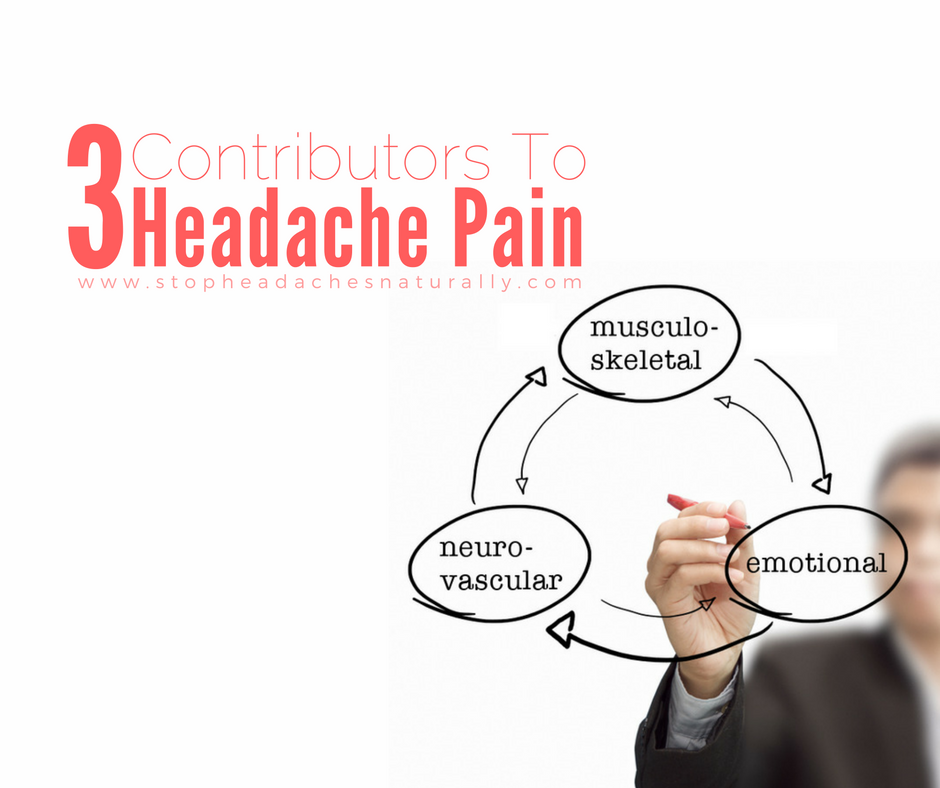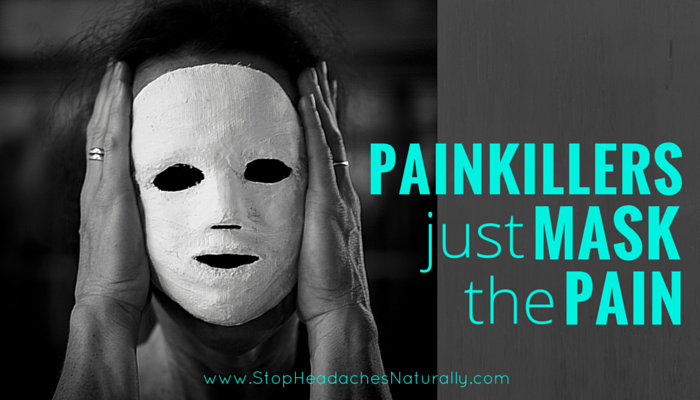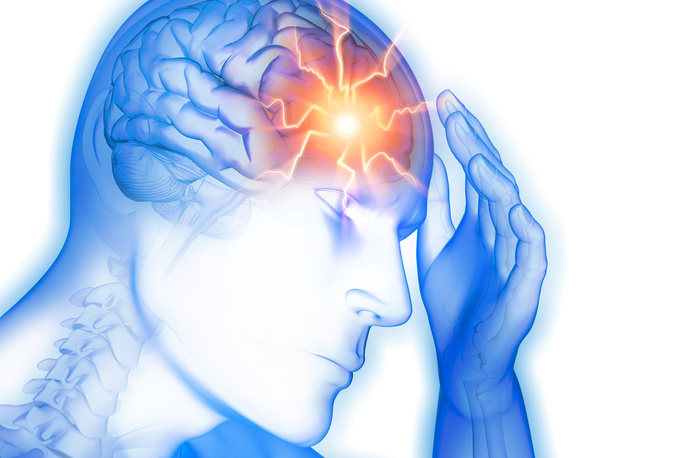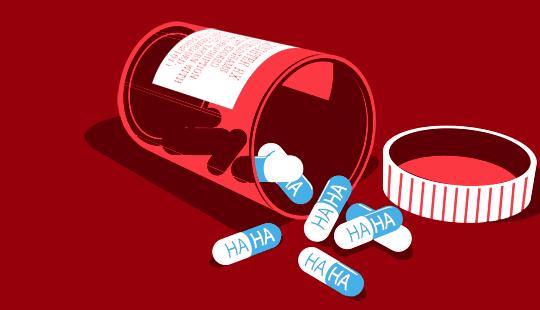3 Reasons You Have Headache Pain

When we started writing this book our focus was on headaches provoked by musculoskeletal problems, and especially by muscular trigger points. However many other factors unrelated to musculoskeletal problems are known to provoke headache attacks, including tiredness, dehydration, certain foods, changes in female hormone levels and flashing lights, to name but a few.
We wanted this book to be useful to as wide range of headache sufferers as possible, so we decided to increase its scope to cover such cases. However we then faced the problem of how to unify all of this information.
From our research we came up with a simple model based on the nature of headache pain. In this model, headache pain arises from a combination of 3 separate contributions:
1. A musculoskeletal contribution – due to problems with muscles and joints
2. A neurovascular contribution – due to changes in nerve activity and blood flow in parts of the brain
3. An emotional stress contribution – this acts like a pain volume control
Reducing any one of these contributions lessens the pain you feel. It may even lessen it sufficiently to prevent a headache from occurring in the first place.
"Reducing any one of these contributions lessens the pain you feel."
There are a number of natural methods available to reduce each of these contributions. For example, the contribution to headache pain from musculoskeletal problems can be readily treated by manual therapy, together with correction of posture, stretching and strengthening of postural muscles.
Emotional stress can be treated by a variety of techniques including relaxation, biofeedback and altering negative thought patterns. The neurovascular contribution can be reduced by making changes to your lifestyle, environment and diet and by reducing emotional stress.
These techniques and more are covered in this book.
This is an excerpt from the ebook Stop Headaches Naturally - Introduction: A Model For Headache Pain
Painkilllers Just Mask The Pain

Frequent headaches can really reduce your quality of life but pain-killers are not the answer
Pain of any sort isn't any fun, but headache pain can stop you thinking clearly. Even a relatively mild headache makes it more difficult to do your work properly and just getting through your daily routine starts to become an effort.
But a severe headache can stop you dead in your tracks and render you unable to function normally. And if the pain is accompanied by typical migraine symptoms of nausea and vomiting then probably all you will be able to manage to do is to go home and collapse into bed.
"It is tempting just to reach for a pain-killer to numb the pain"
What makes it harder is that you often don’t get much sympathy or understanding from those around you, unless they are also badly affected by headaches. Because headaches are extremely common they may be seen as “normal” and not a “proper illness”.
Even our language tends to trivialize headache pain as in the expression “a real headache” for some annoying or difficult problem.
"A headache may be seen as an excuse to avoid responsibility or something you don’t feel like doing"
And a headache may be seen as an excuse to avoid responsibility or something you don’t feel like doing, as in the well-worn cliché “Not tonight dear, I have a headache” for avoiding sex in a relationship.
If you suffer lots of headaches, and particularly if they are severe, it is easy to feel helpless not knowing when a headache will strike again or how to stop it from returning. Headaches can appear in the day or the dead of night.
One time, a headache might hit during a stressful crunch to meet deadlines at work, another may occur in the middle of an uneventful day, and yet another during a pleasurable activity.
The cause of your headaches can look like a complete mystery.
"Makes you an easy target for shrewd marketing campaigns by the pharmaceutical industry with their TV commercials promising “a quick fix” for your headache pain"
All of this makes you an easy target for shrewd marketing campaigns by the pharmaceutical industry with their TV commercials promising “a quick fix” for your headache pain.
It is tempting just to reach for a pain-killer to numb the pain.
While this is understandable and OK every now and then, it is most definitely not a good idea on a long term basis for the following reasons:
- You are only masking the symptoms, not treating the underlying factors that are provoking your headache. Only by understanding and correcting these factors can you can ever hope to be free of headache pain.
- You are actually likely to make your headaches much worse. Instead of occurring perhaps several times a month, they now occur much more frequently, often daily, and the pain is more severe and longer-lasting. This is known as rebound headache or medication overuse headache.
- All medications have side effects. Serious side effects of long-term use of headache painkillers include damage to the gastrointestinal tract, liver and kidneys.
- By relying on a pill, you perpetuate your feeling of helplessness. It seems like headaches are controlling your life and there is nothing you can do about it. If you unravel the factors that are provoking your headaches, you will restore your feeling of being in control of your life, and this may go some of the way towards actually alleviating your headaches.
There are genuine natural alternatives to pain-killers
It is easy to find detailed information about headache medications on the internet. However information about natural therapies for headache is normally presented in a scatter gun fashion in the form of a list of things to try.
That is why we wrote the book Stop Headaches Naturally - Treat The Cause Not Symptoms. The main aim of this book is to provide you with comprehensive, reliable information about the different types of natural therapies which are available for headaches. We have also tried for to organise this information in a way which makes it easier for you to access and apply.
Photo credit: wolfgangfoto / Foter.com / CC BY-ND
Why Does Stress Plus Muscle Tension Equal Headache?

Both migraine and tension headache sufferers list emotional stress, and feelings such as anxiety, worry, fear, anger, and frustration that accompany it, as their most important trigger. But emotional stress is more than a trigger. It is part of the mechanism that produces a headache.
Emotional stress can contribute to headaches by:
- Interfering with natural pain suppression mechanisms
- Increasing the excitability of the brain
- Altering bloodflow to and within the brain
- Causing the release of histamine, a vasodilator and inflammatory substance
- Increasing musculoskeletal pain
On-going stress can lower your headache threshold, making it more likely that exposure to your other triggers will provoke a headache attack. Specific short term stressful episodes may trigger a headache attack. [12]
The role of emotional stress in provoking headaches is reasonably well appreciated. However few headache sufferers are aware that the sustained and excessive amounts of muscle tension may play an equally important role.
Nor are they usually aware of just how tight the muscles in their jaw, neck and shoulders actually are for most of the time. Sustained tension in these muscles is a common response to emotional stress.
It is also the result of maintaining the upper part of your body in a fixed posture. Sitting without moving for lengthy periods of time is a major culprit. Sitting with your neck craned forwards magnifies the problem. This “forward head posture” [13] will also cause pain in the joints of your neck.
Tight or tense muscles are muscles that are actively contracting. However, as we have seen, when muscles stay contracted for too long without relaxing they start to suffer microscopic tissue damage. Various inflammatory substances are released into the muscle fluid from where they are transported into the blood stream.
"when muscles stay contracted for too long without relaxing
they start to suffer microscopic tissue damage"
Hence on-going tension in neck, jaw and shoulders acts as a continual low level source of pain which can reduce your headache threshold. If trigger points are present, tension may irritate them sufficiently to provoke a headache attack.
Muscle tension, like emotional stress, lowers your headache threshold, making a headache attack more likely. Muscle tension can also act as a headache trigger.
[12] JM. Nash and RW Thebarge (2006). “Understanding Psychological Stress, Its Biological Processes, and Impact on Primary Headache.” Headache 46(9):1377- 1386.
[13] DG Borenstein, SW Wiesel and SD Boden (2004). Low back and neck pain: comprehensive diagnosis and management, p231-233, Edition 3, Elsevier.
Laughter Better Than Medicine And Affects The Body Like Exercise

After a real belly laugh and wiping the tears from my eyes, there is no doubt to me that my mind and body are better for it... even though my ribs hurt, it's as if a weight has been lifted off my shoulders.
I have always believed that laughter is as good as medicine. So when I came across this article by dailyhealthpost.com regarding 'mirthful laughter' [*] and it's health benefits, I was interested. I trust that you find it as interesting as I did.
[*] Mirthful: full of or showing high-spirited merriment
Enjoy the read...
We are rife with involuntary reactions. We know why we sneeze. We know why we cough. We know why we blink our eyes. But we don't really know why we laugh.
Sense of humour is personal but everyone has one. We weren't built with extraneous physiological processes, everything our bodies do has a purpose. So while we may not know why we laugh, we now know that doing so contributes to physical and emotional health.
In the 1970s, Norman Cousins, editor of the Saturday Review, published his story of laughter as medicine in The New England Journal of Medicine. He subsequently published books on the subject of mind-body healing: Anatomy of an Illness, Head First, and Mind Over Illness. In these, he explores his experience of having been diagnosed with life-threatening heart disease in 1964 for which he had self-treated with massive doses of vitamin C and laughter. [1] (Cousins died in 1990). His story spurred scientific research into the psychology of laughter - gelotology. Many studies have now shown that laughter does, in fact , promote wellness.
The results are complex and fascinating.
Laughter appears to occur more frequently and has a greater physical impact when it occurs in a group setting. laughing alone is good but laughing with others is even better. The physical act of laughing causes the release of endorphins-neurotransmitters that moderate pain and stress with an opiate effect.
In a controlled study, pain threshold was significantly higher after laughter than without. [2] Even anticipation of the prospect of "mirthful laughter" reduces stress hormone levels and increases endorphins and human growth hormone (which contributes to optimizing immunity).
A study of high-risk diabetics found that:
“the addition of an adjunct therapeutic mirthful laughter Rx (a potential modulator of positive mood state) to standard diabetes care may lower stress and inflammatory response and increase 'good' cholesterol levels. The authors conclude that mirthful laughter may thus lower the risk of cardiovascular disease associated with diabetes mellitus and metabolic syndrome.” [3]
The benefits of laughter don't stop there.
The physical act of laughter - not just a chuckle, but real, belly-type laughter - is exercise. If you've ever had one of those episodes (and we certainly hope that you have) in which you laugh so hard that you cry and can't breathe, you know that you could be a little sore afterward. Without thinking, the act of laughing promotes various physical activities:
1. Laughter dilates blood vessels, improving circulation, and exercises abdominal, facial and other muscle groups.
2. The release of growth hormones and dopamine in the brain bring a sense of euphoria and happiness - a high that improves not only mood but supports immune function.
3. With the release of hormones and neurotransmitters during and following a bout of laughter, blood sugar and cholesterol levels are reduced. These effects can last for days, especially if laughter is a regular part of your life.
4. With the highs comes the lows - in a good way: improved blood flow and body nourishment, the reduction of stress and pain, and emotional contentment are followed by greater relaxation and better sleep quality.
Science was loth to investigate the phenomenon of laughter until fairly recently. Unlike other involuntary response, it seemed... click here to read the rest of this article.
Source [1] [2] [3]
Pablo Tymoszuk is a soft tissue therapist specialising in remedial, myofascial and dry needling techniques. He also acts as an ergonomic specialist and wellness consultant which has motivated him to co-author the eBook Stop Headaches Naturally.
Together with Dr Margaret Scarlett they present a range of strategies for stopping headaches and migraines without drugs. All strategies are organized in a systematic manner and backed up by references to the scientific literature.
Anger Is A Health Hazard

Anger is a conundrum of complexities that affect each and every person differently. Are you a road-rager? A passive aggressive? Short fused?
Anger is a normal human emotion that is rarely a pretty one; it can be downright embarrassing, dangerous, with significant negative affects on the human body.
There is a flipside to negative anger, when managed well it can be: a healthy release, a motivator for change or a self-empowering tool.
The spectrum of anger ranges from mild frustration and annoyance to out of control rage; affecting your emotional, physical and cerebral state. The part of the brain that responds first when anger strikes is the amygdala. You can find it located deep within the temporal lobe of the brain.
The amygdala controls emotion and the instinctive ‘fight or flight’ response to fear, feeling threatened and stress. It is able to process a magnitude of information, assessing the possible dangers within milliseconds; allowing you to react first and think later.
Above the amygdala within the frontal lobe lies the ability to make decisions, solve problems and behavior. When anger hits, blood rushes through the frontal cortex clouding rational thought; depending on the person, this flash reaction can be either helpful or harmful. The old adage of ‘count to ten before reacting’ comes in handy here.
The domino effect of anger continues with the adrenal glands saturating the system with the stress hormones adrenaline and cortisol, giving you a burst of energy and added strength. This redirects blood flowing to the stomach and intestines to the muscles instead, in preparation to fight. Your blood pressure, pain threshold and temperature raise, breathing and heart rate increase, the pupils begin to dilate.
All the above happens each time anger or frustration get the best of you. How many times a day do you yell at the person who cut you off or the automated service that will not redirect you or your significant other? Anger not only affects the people around you, it is also is directly linked to your cardiovascular health and mental well-being.
According to Heart MD, “Higher levels of fatty acids and blood sugar are released to provide immediate energy to survive the perceived emergency.” The problem with the continued release of these fatty acids is overtime they start to build up in the arteries, setting you on a path towards heart disease. If you are someone who is constantly battling with anger, you are putting your health at a much higher risk for coronary heart disease or heart attack.
If you are an angeraholic, another issue you need to consider is the direct result of daily anger damaging the brain. Researchers have found that a continued supply of ‘trigger and effect anger’ may confuse the hippocampus (stress responder in the brain) and result in the inability to suppress your anger response all together.
There have also been studies showing anger in the brain disrupts the growth of new neurons, essential to sending messages and communicating with the rest of the body.
Some known health problems associated with anger include:
• Depression
• Anxiety
• Sleeplessness
• High Blood Pressure
• Risk of Coronary Disease
• Skin problems like increased acne
• Headaches or Migraines
• Digestive irregularities
Anger Management Tips
If you are a hothead who cares about your health, who cares about prolonging your future, anger management is right up your alley. Keep in mind that adopting and replacing a bad habit with a new one takes practice and doesn’t practice make perfect?
Try these anger management tips suggested by the Mayo Clinic:
• Think before you speak
• Let your mind clear before expressing your thoughts so you can think clearly
• Exercise to work off the frustration
• Walk away and Take a Timeout before you say or do something you might regret
• Refocus your anger to finding solutions instead of concentrating on the problem
• Stick with ‘I’ statements when expressing your feelings, so the discussion does not become about who’s fault it is instead of the real issues
• Learn to forgive
• Laugh Laugh Laugh. Even at the height of an argument, if you force yourself to take a moment and start laughing, your mood immediately changes
• Learn relaxation skills that are most beneficial to you in most situations: breathing slowly as you concentrate on your breath, yoga, write your feelings down in a journal, look in a mirror and remind yourself to calm down and relax over and over again until you start to feel calmer
• Realize when anger management tips are not enough and seeking help would be more beneficial
• Don’t let anger take you over, ruining the important things in your life that mean the most. Prolonged manifestations of anger are detrimental to the heart and the brain. Learning to convert anger into a positive experience will make your life a happier place
Source
Pablo Tymoszuk is a soft tissue therapist specialising in remedial, myofascial and dry needling techniques. He also acts as an ergonomic specialist and wellness consultant which has motivated him to co-author the eBook Stop Headaches Naturally.
Together with Dr Margaret Scarlett they present a range of strategies for stopping headaches and migraines without drugs. All strategies are organized in a systematic manner and backed up by references to the scientific literature.





